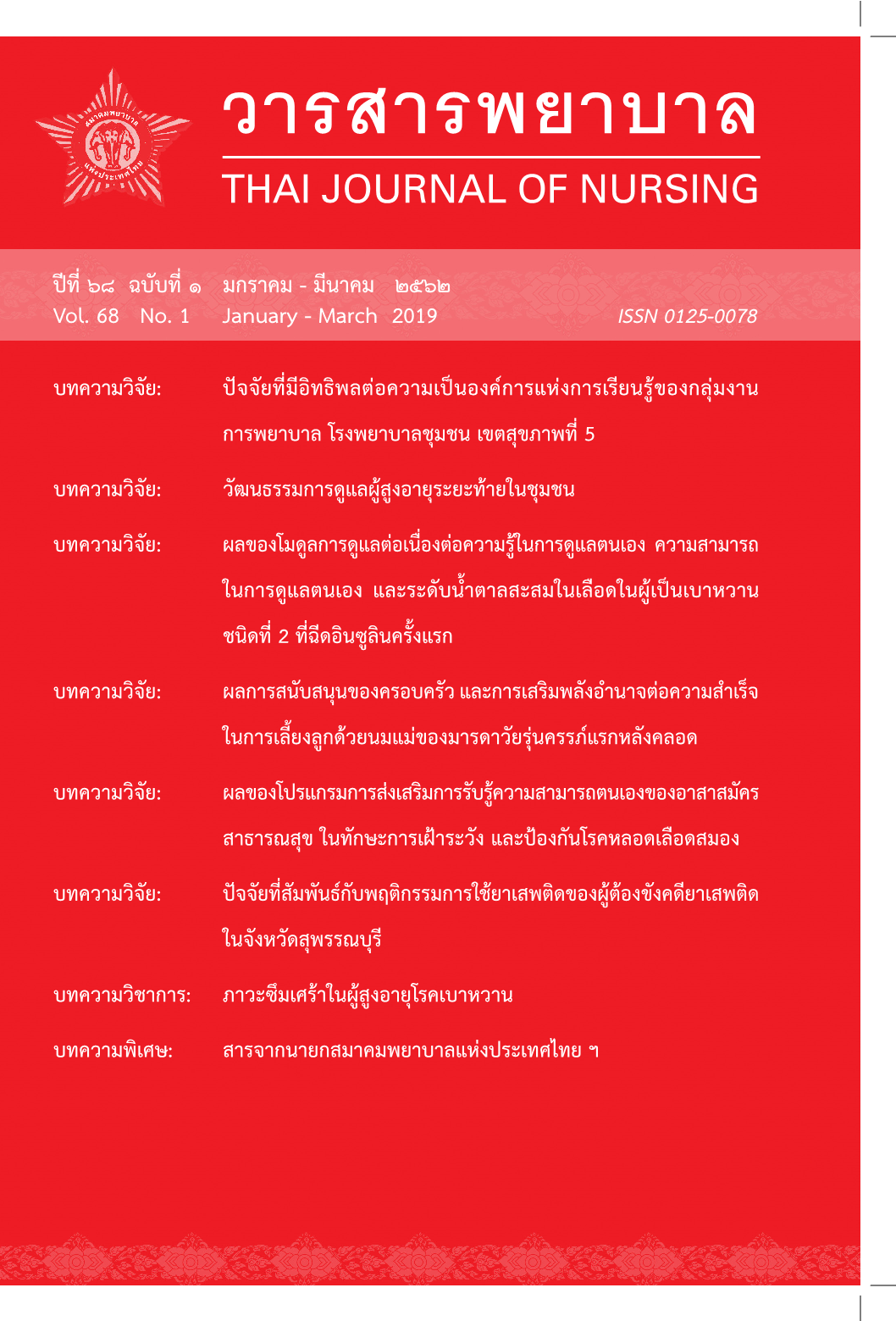The effects of self-efficacy enhancement program for health volunteers on stroke surveillance and prevention
Main Article Content
Abstract
The purpose of this quasi-experimental study was to investigate the effects of the volunteer self-efficacy promotion program on stroke surveillance and prevention. The experimental group received the volunteer self-efficacy promotion program through workshop and coaching during home visits. Data was collected by self-administered questionnaire and analyzed by using descriptive statistics, t-test and the repeated measures ANOVA. Results indicate that in the experimental group, knowledge of stroke, self-efficacy and surveillance and prevention of stroke after the experiment and follow-up period, had a significantly higher mean score than that before the experiment ( p <.05 ). When compared between groups it was found that the experimental group had a significantly higher mean score of knowledge of stroke, self-efficacy and surveillance and prevention of stroke after the experiment and 4 weeks follow-up than the comparison group ( p < .05 ).
Article Details
References
ตนเองเพื่อส่งเสริมพฤติกรรมการออกกำลังกายของผู้ป่วยโรคความดันโลหิตสูงชนิดไม่
ทราบสาเหตุ. Veridian E-Journal Silpakorn University (Humanities, Social
Sciences, and Arts), 7(1), 62-72.
กระทรวงสาธารณสุข กลุ่มพัฒนาระบบสาธารณสุข. (2560). ประเด็นสารรณรงค์วันอัมพาตโลก ปี
2560. สืบค้นเมื่อ 15 พฤศจิกายน 2560, จาก https://www.thaincd.com/ document/ file/
info/ non-communicable
กระทรวงสาธารณสุข กองยุทธศาสตร์และแผนงาน. (2559). สถิติสาธารณสุข พ.ศ. 2559. สืบค้น
เมื่อ 15 พฤศจิกายน 2560, จาก https://bps.moph.go.th/new_bps/
กระทรวงสาธารณสุข สำนักโรคไม่ติดต่อ. (2558). การประเมินปัจจัยเสี่ยง CVD ด้วยวาจา 9 ข้อ.
สืบค้นเมื่อ 2 สิงหาคม 2560, จาก https://mkph.healtharea.net/index.php/en/2013-08-
23-08-06-09/doc_view/136-1-screening-version-final-291014
กระทรวงสาธารณสุข สำนักนโยบายและยุทธศาสตร์. (2560). รายละเอียดตัวชี้วัดกระทรวง
สาธารณสุขประจำปีงบประมาณ 2560 (Template Key Performance Indicator Ministry of
Public Health 2017). นนทบุรี: ผู้แต่ง.
กรุงเทพมหานคร สำนักอนามัย กองสร้างเสริมสุขภาพ. (2558). หลักสูตรการอบรมปฐมนิเทศ
อาสาสมัครสาธารณสุข (อสส.) ฉบับปรับปรุง พ.ศ. 2551. กรุงเทพมหานคร: ผู้แต่ง.
กรุงเทพมหานคร ศูนย์เตือนภัยสุขภาพคนกรุงเทพ. (2558). รายงานเบื้องต้นข้อมูลสุขภาพคน
กรุงเทพมหานคร(พิมพ์ครั้งที่1). กรุงเทพมหานคร: ไอ ปริ้นติ้ง คัลเลอร์.
ฐิติมา อินทร์เนตร, อาภาพร เผ่าวัฒนา, ปาหนัน พิชยภิญโญ, และทัศนีย์ รวิวรกุล. (2554). การ
พัฒนาสมรรถนะแห่งตนร่วมกับการเรียนรู้แบบมีส่วนร่วมของอาสาสมัครสาธารณสุขในการส่ง
เสริมสุขภาพผู้สูงอายุที่เป็นโรคความดันโลหิตสูง. วารสารสาธารณสุขศาสตร์, 41(1), 5-16.
ณัฐสุภรณ์ โพธิ์โลหะกุล. (2555). การประยุกต์ทฤษฎีการรับรู้ความสามารถตนเองในการออก
กำลังกายด้วยโยคะของนักศึกษาหญิง มหาวิทยาลัยเทคโนโลยีราชมงคลธัญบุรี จังหวัด
ปทุมธานี. วารสารสาธารณสุขศาสตร์, 42(2), 29-43.
ปราณี เรียนถาวร, อรวรรณ แก้วบุญชู, ทัศนีย์ รวิวรกุล, และปาหนัน พิชยภิญโญ. (2556). ผล
ของโปรแกรมการส่งเสริมสมรรถนะแห่งตนต่อทักษะการดูแลผู้สูงอายุโรคข้อเข่าเสื่อมของ
อาสาสมัครสาธารณสุข. (วิทยานิพนธ์มหาบัณฑิต ไม่ได้ตีพิมพ์). มหาวิทยาลัยมหิดล,
กรุงเทพมหานคร.
ภูดิท เตชาติวัฒน์, และนิทรา กิจธีระวุฒิวงษ์. (2557). ประสิทธิผลของโปรแกรมการฝึกอบรม
อาสาสมัครสาธารณสุขประจำหมู่บ้านในการดูแลผู้ป่วยโรคหลอดเลือดสมองในชุมชนด้วย
การจัดการเรียนรู้โดยใช้บริบทเป็นฐาน. วารสารการพยาบาลและการดูแลสุขภาพ, 32(1),
87-96.
Bandura, A. (1997). Self- Efficacy the exercise of control. New York: W. H.
Freeman.
Polit, D. F., & Hungler, B. P. (1999). Nursing research: Principles and methods.
Philadelphia, PA: J. B. Lippincott.


